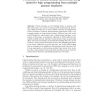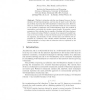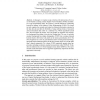128 search results - page 7 / 26 » Data-driven Induction of Functional Programs |
DIS
2006
Springer
13 years 11 months ago
2006
Springer
Protein domains are the building blocks of proteins, and their interactions are crucial in forming stable protein-protein interactions (PPI) and take part in many cellular processe...
LPAR
1999
Springer
13 years 11 months ago
1999
Springer
Abstract. Walther’s estimation calculus was designed to prove the termination of functional programs, and can also be used to solve the similar problem of proving the well-founde...
ENTCS
2007
13 years 7 months ago
2007
The tracer Hat records in a detailed trace the computation of a program written in the lazy functional language Haskell. The trace can then be viewed in various ways to support pr...
DIS
2005
Springer
14 years 1 months ago
2005
Springer
Abstract. In this paper we explore a topic which is at the intersection of two areas of Machine Learning: namely Support Vector Machines (SVMs) and Inductive Logic Programming (ILP...
ML
2006
ACM
13 years 7 months ago
2006
ACM
The application of Inductive Logic Programming to scientific datasets has been highly successful. Such applications have led to breakthroughs in the domain of interest and have dri...



